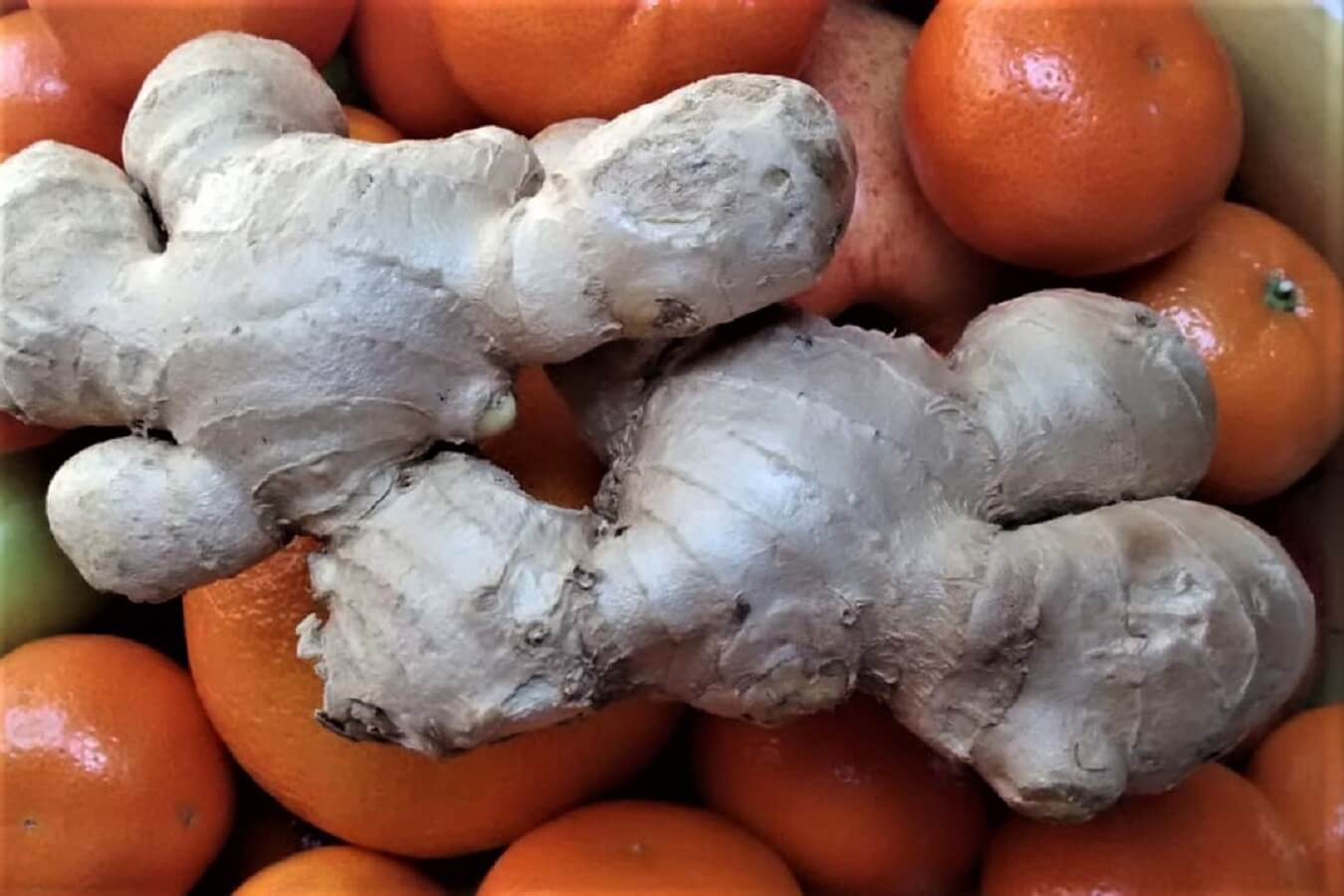Benefits of Ginger
Contents:
- Benefits of Ginger to the Body
- Active Ingredients of Ginger
- Uses in the Kitchen
- Bioactive Components
- Interesting Ginger Facts
- Side Effects and Warning
- Sources, at bottom of page
Benefits of Ginger.
In Health and in the Kitchen
Where does the word Ginger come from?
- The original name of this plant and its root was "sringavera", a Sanskrit word that means "body in the form of a horn"
- In Persia it was known as "dzungebir"
- In ancient Greece they called it "dzingíberis"
- Later the Romans identified it as "zingiber" which passed as "jengibre" in Spanish, and in English as "ginger"
The scientific name for ginger is Zingiber Officinale.
This interesting vegetable belongs to the Zingiberaceae family, therefore it is closely related to turmeric, cardamom and galangal (blue ginger).
Description of Ginger
- Ginger root is a rhizome with knobby and semi-rough finger-like projections
- Its color is light tan, sometimes similar to wood
- The pulp is juicy and slightly yellow in color, giving off a spicy, somewhat sweetish aroma.
- As the rhizome gains volume underground, the foliage grows upwards above the surface
What does ginger taste and smell like?
The taste of fresh ginger is slightly fiery and sweet, and to the nose it is aromatic and spicy.
Ginger: Uses. What is it for
For several millennia, ginger root has been consumed around the world for both culinary and medicinal purposes.
Uses of Ginger in the Kitchen
In the kitchen, the benefits of ginger are the aroma and flavor that it provides to savory dishes and sweet drinks in a wide range of cuisines, from Asian to Caribbean to African and Western.
Fresh ginger is used in countless preparations including marinades, soups, and stews.
Ginger provides a strong, spicy and refreshing flavor to countless culinary preparations, from meats and seafood to vegetables, desserts and beverages.
For use, ginger is available in seven forms: fresh, dried, pickled, preserved, crystallized, candied and powdered.
Culinary Uses of Ginger
- Marinades
- Sauces
- Pests
- Curry
- Soups
- Herbal teas
- Shakes
- Dressings
- Sauteed
- Steamed
- In stir-fries
- Ginger juice for certain recipes
- Pickled ginger as a condiment
- Ground ginger to add to any culinary mix
Dishes and Drinks of the World that include Ginger as an Ingredient
- Sashimi and sushi, in Japan
- Sambharam, South India
- Kimchi, traditional Korean dish
- Salabat, in the Philippines, is ginger tea
- Masala Chai, Curry, Tea and Coffee, in India
- Beni shōga, in Japan, is pickled ginger
- Ginger beer and ginger cake, in Jamaica
- Tsitsibira, in Greece, is a type of ginger-based beer
- Katlu, in India, is powdered ginger with ghee, walnuts and sugar
- Domaine de Canton, in France, is a ginger and cognac-based liqueur
- Wedang jahe, in Indonesia, is a drink with ginger and palm sugar
- Gyin-thot, in Burma, is a salad made from grated ginger preserved in oil
- Ras el Hanout is an Arabic dish made from a wide variety of spices including ginger
Nutritional Content of Ginger in a Serving of 100 g
Macronutrients
- Carbohydrates: 18 g = 7%
- Dietary fiber: 2 g = 7%
- Protein: 1.82 g = 4%
- Calories: 80 = 4%
- Fat: 0.8 g = 1%
- Fatty acids: Omega 3, Omega 6 and Fitosterolese
Vitamins
- B6: 0.2 mg = 11%
- Vitamin C: 5 mg = 6%
- Niacin (B3): 0.8 mg = 5%
- Choline: 29 mg = 5%
- Folate (B9): 11 mcg = 3 %
Minerals
- Copper 0.2 mg = 25%
- Magnesium: 43 mg = 11%
- Potassium: 415 = 9%
- Iron: 0.6 mg = 3%
- Phosphorus: 34 mg = 3%
- Calcium: 16 mg = 1%
- Sodium: 13 mg = 1%
- Selenium: 0.7 mcg = 1%
Health Benefits of Ginger
The importance of ginger in this field is due to its bioactive components that include a very wide spectrum of essential oils and of spicy substances among which gingerols abound.
It is these phytochemical components to which the antiarthritic, anti-inflammatory, antidiabetic, antibacterial, antimiotic and even anticancer effects are attributed, which is why this plant is under the scrutiny of scientific researchers.
Ginger contains gingerol, a substance that appears to have protective effects against cancer. However, more studies are needed.
The benefits of ginger are derived from the properties of its essential oils and resins.
- Ginger root is rich in volatile oils which contain gingerol.
- Gingerol is the main active component of the plant
- Gingerol is attributed several important pharmacological and physiological activities
- The root is the part of ginger where alternative medicine has focused
- The characteristic taste and smell of ginger is due to shogaols and gingerols.
Ginger has been cultivated and used for several thousand years in the traditional Asian pharmacopoeia as a carminative, antiemetic, digestive stimulant, diaphoretic, and expectorant.
Situations where the benefits of ginger appear to have been of apparent help include:
colds, nausea, stomach aches, diarrhea, arthritis, migraines, and hypertension.
Ginger has undergone numerous clinical trials that seem to confirm that its root is a positive aid against nausea.
- Inhaled ginger essential oil is now known to be a very effective remedy for ginger.
- Ginger also helps activate the immune response to fight viral infections.
- The benefits of ginger in certain cases of sore throats caused by viruses that cannot be treated with antibiotics, include relieving sore throats and speeding up recovery time.
Ginger: interesting Facts
- India is the main ginger producer.
- The USA, Japan and the Netherlands are the main ginger consumers.
- Ginger appears to be native to South Asia where the main producers are India, China, Nigeria, Nepal, Indonesia and Thailand.
- Gingy, the little man who accompanies Shrek in his movies, is made of ginger.
- In Ireland and Scotland the word "ginger" has been used for centuries as a nickname for redheads.
- Traditional ginger beer is a drink made from cream of tartar, lemon juice, sugar and, of course, fresh ginger.
- Zevia Ginger Ale, the vegan version of the classic ginger ale, contains ginger extract, carbonated water, citric acid, stevia leaf extract, and natural flavors.
- Ginger beer, along with vodka and lime juice, is an ingredient in the cocktail known as Moscow mule, Moscow mule, or vodka buck.
- Domaine de Canton is a liqueur that is made in France from ginger and cognac, but originally made in Wangdong, China.
Ginger: side Effects and Contraindications
- After scientific research, healthy people are recommended not to consume more than 4 grams of fresh ginger per day.
- Ginger is well tolerated in doses less than 5 grams per day.
- A 1.5 cm slice of medium-sized fresh root weighs about 4 grams.
Ask your doctor how much ginger you can eat in the following cases:
- During pregnancy
- you are taking anticoagulants
- gallstone disease
- have a history of gallstones
- you are taking any anticoagulant drugs (warfarin)
- you have been prescribed hypoglycemic medications
- you want to apply ginger to the skin (it can cause dermatitis)
- you are taking heart medications
- you have diabetes or any other disease
- before and after surgery
Ginger should be consumed with caution.
At high doses there is a greater risk of adverse effects. The most common are:
abdominal pain, diarrhea, itchy mouth and throat and, in extreme cases, vomiting and cardiac arrhythmias.
Health Disclaimer
This information on Benefits of Ginger is for educational purposes only, and does not substitute the professional medical advice.
The data presented here are based on research done by organizations specialized in nutrition such as:
fda.gov / nutrition.gov / fdc.nal.usda.gov / PubMed / ScienceDirect / ods.od.nih.gov / medlineplus.gov
Consult a medical professional or healthcare provider if you are seeking medical advice, diagnosis, or treatment.
• • • • •


